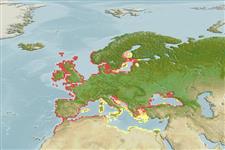Common names from other countries
>
Syngnathiformes (Pipefishes and seahorses) >
Syngnathidae (Pipefishes and seahorses) > Nerophinae
Etymology: Nerophis: Greek, neros, nearos = youhtfull appearance + Greek,ophis = serpent (Ref. 45335).
More on author: Linnaeus.
Environment: milieu / climate zone / depth range / distribution range
Ecologie
marien; zoet water; brak water demersaal; diepte 2 - 15 m (Ref. 6733). Temperate; 63°N - 30°N, 11°W - 42°E
Eastern Atlantic: Norway to Morocco (excluding region from Denmark to Netherlands), also throughout the Mediterranean and the Black Sea.
Grootte / Gewicht / Leeftijd
Maturity: Lm ? range ? - ? cm
Max length : 29.0 cm TL mannelijk / geslacht onbekend; (Ref. 2058); 30.0 cm TL (female)
Anal, caudal and pectoral fins absent (Ref. 59043). Anal opening below front end of the dorsal fin, 28-33 body rings. Has a strait snout (Ref. 35388).
Inhabit algal zone or eel-grass (Zostera) (Ref. 6733). Adults spawn in May - August . Feed on small crustaceans and fish fry (Ref. 35388). Ovoviviparous (Ref. 205). The male carries the eggs in a brood pouch which is found under the tail (Ref. 205). Consistent paternity is ensured despite brooding of embryos on the outside the male's body. Events of cuckoldry by sneaker males is ruled out through genetic paternity analyses based on molecular markers (Ref. 81011). Each male carries eggs from a single female but females may deposit eggs on several brooding pouches (Ref. 81011).
Levenscyclus en paargedrag
Maturities | Voortplanting | Spawnings | Egg(s) | Fecundities | Larven
Consistent paternity is ensured despite brooding of embryos on the outside of the male's body instead of a brood pouch characteristic of the family (Ref. 81011, 53335). Events of cuckoldry by sneaker males is ruled out through genetic paternity analyses based on molecular markers (Ref. 81011). Each male carries eggs from a single female but females may deposit eggs on several brooding pouches (Ref. 81011).
Dawson, C.E., 1986. Syngnathidae. p. 628-639. In P.J.P. Whitehead, M.-L. Bauchot, J.-C. Hureau, J. Nielsen and E. Tortonese (eds.) Fishes of the North-eastern Atlantic and the Mediterranean. Volume 2. Unesco, Paris. (Ref. 6733)
Status op de Rode Lijst van het IUCN (Ref. 130435)
CITES (Ref. 128078)
Not Evaluated
Gevaar voor de mens
Harmless
Gebruik door de mens
Visserij: van geen belang
Tools
Speciale rapporten
Download XML
Internetbronnen
Estimates based on models
Preferred temperature (Ref.
115969): 8.6 - 19.3, mean 13.5 (based on 981 cells).
Fylogenetische diversiteitsindex (Ref.
82804): PD
50 = 0.6250 [Uniqueness, from 0.5 = low to 2.0 = high].
Bayesian length-weight: a=0.00085 (0.00032 - 0.00224), b=3.04 (2.81 - 3.27), in cm Total Length, based on LWR estimates for this (Sub)family-body shape (Ref.
93245).
Trofisch niveau (Ref.
69278): 3.5 ±0.47 se; based on food items.
Weerstandsvermogen (Ref.
120179): Hoog, minimale populatieverdubbelingstijd minder dan 15 maanden (K=1.05).
Fishing Vulnerability (Ref.
59153): Low vulnerability (17 of 100).
